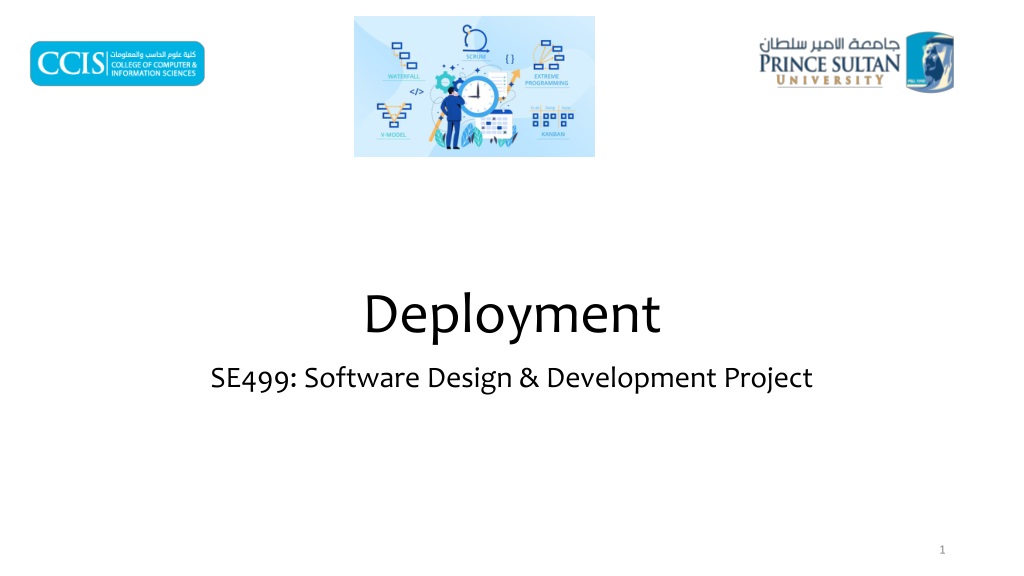

0 likes | 26 Views
Deployment in software development is a crucial step that involves releasing software to end-users, impacting performance, security, and user experience. Factors to consider include availability, accessibility, and compliance. Various deployment types and strategies exist, with best practices emphasizing automation, testing, monitoring, and documentation. Challenges like downtime and security risks can be mitigated through careful planning and continuous improvement. Open source tools like Docker and Kubernetes offer flexible, cost-effective solutions for deployment. Integrating with platforms like Digital Ocean and GitHub streamlines deployment workflows for efficient software delivery.

E N D
Deployment SE499: Software Design & Development Project 1
Introduction • "The process of making software available for use by end-users“ • Deployment is the final step in the software development lifecycle, where the software is released to the end-users. • This involves hosting the software on a server, configuring the environment, and making sure it's accessible to the users. 2
The Role of Deployment in Software Development • Software development lifecycle: planning, design, development, testing, deployment, maintenance • Deployment's role: making software available for use, providing feedback loop for further development • Deployment's impact on software quality: • Performance • Security • Maintainability • User experience 3
Critical factors to consider • Ensures software availability and accessibility • Affects user experience and satisfaction • Impacts business operations and revenue • Security and compliance considerations • Continuous deployment and integration 4
Deployment • Proper deployment is crucial for the success of any software development project. • By understanding the importance of deployment and following best practices, you can ensure that your software is available, accessible, and secure for your end-users. 5
Types of Deployment • On-premise deployment • Cloud deployment • Hybrid deployment • Continuous deployment 6
Deployment Strategies • Big Bang deployment • all features are deployed at once • Phased deployment • features are deployed gradually over time • Canary deployment • features are deployed to a small group of users first, then gradually rolled out to more users 7
Deployment Best Practices • Automating deployment processes • Testing deployments thoroughly before deploying to production • Monitoring deployments for issues and performance • Documenting deployment processes and procedures 8
Tips and tricks for successful deployments • Plan and test deployments in advance • Use version control for deployment scripts • Monitor and troubleshoot deployments • Continuously improve and refine deployment processes • Document deployment procedures 9
Challenges and Risks • Downtime and outages • Security risks • Compatibility issues • Performance issues 10
Open Source • Software with source code available for anyone to study, modify, and distribute • Benefits of open source tools: • Cost-effective • Community-driven development • Flexibility and customization • Security • Quality 11
Examples of open source deployment tools • Docker • Kubernetes • Ansible • Puppet 12
• Docker is a containerization platform for applications • Use cases: • Benefits: • Developing and testing applications • Lightweight and portable containers • Developed by Solomon Hykes and his team at Docker Inc. in 2013 • Deploying web applications • Faster development and deployment cycles • Creating microservices architecture • Allows developers to package an application and its dependencies into a lightweight, portable container • Isolation and security • Data science and machine learning • Efficient resource utilization • Collaboration and reuse of images and containers • DevOps and continuous integration/continuous deployment (CI/CD) 13
• Kubernetes (k8s) is an open-source container orchestration platform • Use cases: • Benefits: • stateless web servers • scalability and flexibility • stateful databases • automated deployment and rolling updates • Developed by Google, now maintained by the Cloud Native Computing Foundation (CNCF) • CI/CD pipelines • self-healing and fault tolerance • machine learning models • edge computing • efficient resource utilization • Automates deployment, scaling, and management of containerized applications • platform-agnostic, multi- cloud support 14
Digital Ocean: A Cloud Provider for Students • Why Digital Ocean is a great option for student projects and deployments: • Affordable pricing • Easy to use and manage • Scalable resources • High-performance infrastructure • Seamless integration with GitHub for automated deployments • Easy setup and management of deployment workflows 15
GitHub Integration: Streamlining Deployment • Benefits of GitHub integration: • Automated deployments • Version control for deployment scripts • Collaboration and access control • Continuous integration and delivery 16